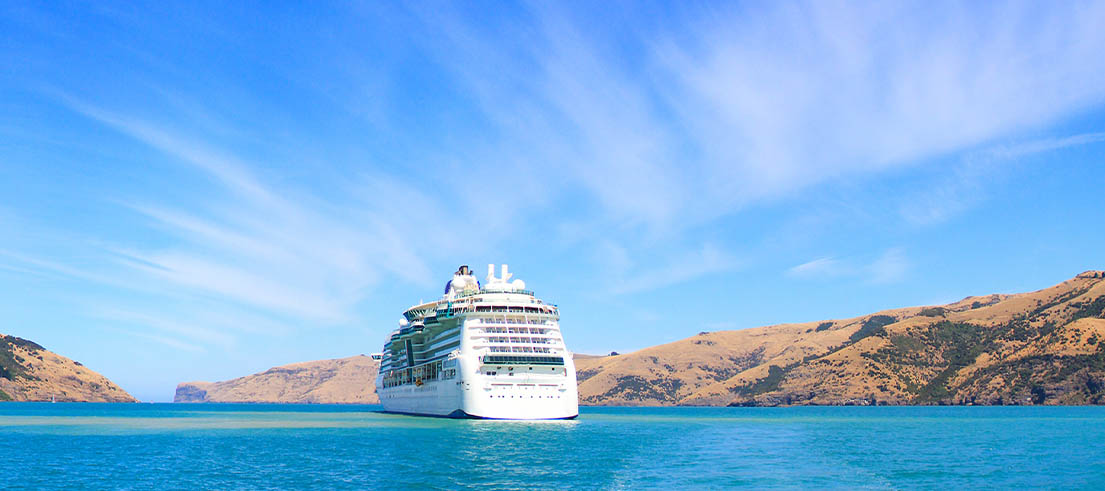
Report on cruise ships in Akaroa Harbour released
Further scientific research is required to determine any environmental impact caused by cruise ships operating in Akaroa Harbour, regional harbourmaster Jim Dilley says, following the release of an Environmental Risk Assessment report.
Environment Canterbury commissioned the report, including a review of all available research, in response to concerns from within the Akaroa community that cruise ships operating in the harbour may be damaging the seabed.
"The preliminary findings are that any potential effects can be appropriately managed, but it does highlight that the available research is not sufficient to provide a definitive answer, and recommends further research be conducted," Dilley said.
"Environment Canterbury will require the cruise industry to provide an independent scientific study during the next 24 months, which we believe will identify exactly what is taking place and will allow us to address any concerns. The timeframe is necessary to determine any ecological impact and recovery cycle."
In parallel with the report, the Regional Harbourmaster's Office and the cruise industry worked with community groups and Christchurch City Council to identify areas of concern to ensure suitable risk mitigations are in place for the upcoming cruise season.
The report (PDF File, 18.45MB) – an Environmental Risk Assessment – is a review of existing science and information. It was commissioned to establish what possible effects, if any, may be caused by the operation of cruise ships in Akaroa Harbour. It was completed by the Cawthron Institute.
The key findings are:
- There is minimal available science
- There is potential for some effects of varying degrees
- The direct disturbance of the seabed could be considered to have less than minor to minor adverse effects
- Based on the science available, effects are manageable if mitigations are in place
Find out more about the report
The report covers a wide variety of possible effects from cruise ship operations, all of which are already subject to existing legislative controls and mitigations.
The one exception is the possible effects to the seabed caused by a vessel anchoring. Some of the larger vessels may disturb a larger volume of the seabed than permitted within the Regional Coastal Environment Plan (RCEP). Environment Canterbury will now focus on the possible effects of anchoring.
The use of propulsion equipment (thrusters, pods and other propulsion equipment) is allowed under maritime law. In the case of propulsion equipment, the Resource Management (Marine Pollution) Regulations 1998 applies.
Schedule 4, section 15, describes “ship propulsion” as part of the “normal operations” of the ship. Environment Canterbury has discussed this with cruise ship operators and secured agreement that the use of thrusters will continue to be minimised in Akaroa harbour.
Environment Canterbury will discuss the ongoing operations of cruise ships in Akaroa Harbour with the cruise industry and establish the actual effects. This may inform the level of permitted cruise ship operations in Akaroa Harbour in the future.
- Identified anchorages and requirement to use these anchorages. This provides safe anchorage locations where ships do not endanger each other and ensure any seabed disturbance does not impact wide swaths of the Harbour
- Wind limits are in place that prevent ships entering the Harbour, or remaining in the harbour, when it is unsafe to do so. The wind limits also serve to minimise the possible dragging of an anchor and limit the swing area of a vessel. This minimises possible seabed disturbance
- Minimum under keel clearance (UKC) requirements are in place to ensure safe navigation and additionally they minimise possible disturbance of the seabed
- Noise controls in place
- Light controls replicating Department of Conservation standards (Akaroa Harbour Principles of Operation)
- Marine oil pollution response plan
- On-site rapid pollution response equipment
- Trained pollution response staff (Environment Canterbury and Department of Conservation)
- Operational oversight and audit (on-site staff and manning)
- An agreed set of principles of operation outlining expected standards of operation
- Limitations on the use of thrusters except for the safe manoeuvring of the vessel and/or safe embarkation/disembarkation of passengers
- Limitations on the use of certain fuels
A breach of the Resource Management Act requires two components – a breach of the Regional Coastal Environment Plan and proven adverse effects.
There is no clear evidence of adverse efffects from cruise ship operations. The reports notes possible effects can be appropriately mitigated with the measures currently in place.
What are the operating standards
These control measures have included the provision of an agreed set of standards for vessels operating at Akaroa. These standards, the Akaroa Harbour Principles of Operation, are included in the updated Navigation Safety Operating Requirements (PDF File, 4.13MB).
They include:
- Identified anchorages and requirement to use these anchorages. This provides safe anchorage locations where ships do not endanger each other and ensure any seabed disturbance does not impact wide swaths of the Harbour
- Wind limits are in place that prevents ships entering the Harbour, or remaining in the harbour, when it is unsafe to do so. The wind limits also serve to minimise the possible dragging of an anchor and limit the swing area of a vessel. This minimises possible seabed disturbance
- Minimum under keel clearance (UKC) requirements are in place to ensure safe navigation and additionally, they minimise possible disturbance of the seabed
- There are noise controls in place
- Light controls replicating Department of Conservation standards (Akaroa Harbour Principles of Operation)
- Marine oil pollution response plan
- On-site rapid pollution response equipment
- Trained pollution response staff (Environment Canterbury and Depart of Conservation)
- Operational oversight and audit (on-site staff and manning)
- An agreed set of principles of operation outlining expected standards of operation
- Limitations on the use of thrusters except for the safe manoeuvring of the vessel and/or safe embarkation/disembarkation of passengers
- Limitations on the use of certain fuels
